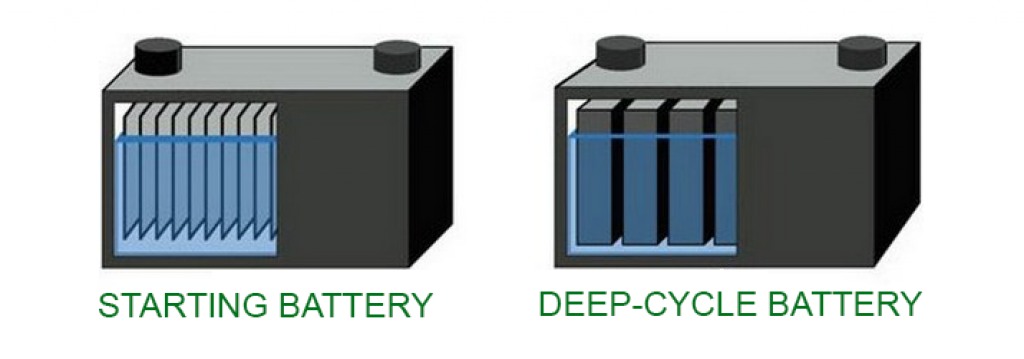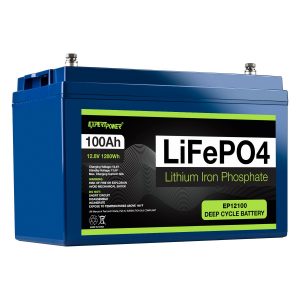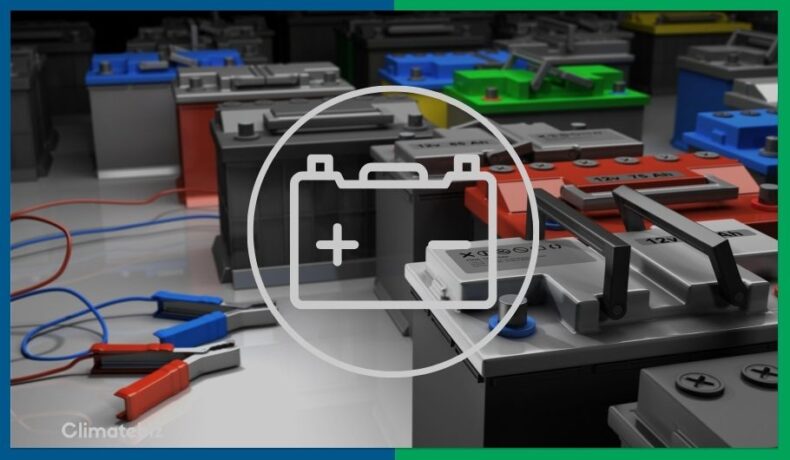Do Deep Cycle Batteries Need To Be Vented?
If you’re asking yourself this question, it’s safe to say you’re on the right path.
Why?
Well, it’s an essential question to ask yourself before setting up your energy storage system, and it shows you’re well on your way to achieving energy autonomy.
But back to the question at hand -the answer depends on the type of deep cycle battery you want to use.
Nowadays, there are different types of deep cycle batteries, which vary in their materials, chemical makeup, performance, and price.
Although they provide a reliable and stable energy source, one of these types – flooded lead-acid – requires venting (more about that later on).
If you’re looking to learn more about the most widely used types of deep-cycle batteries and why some of them require venting, read on!
Table of Contents
Do Deep Cycle Batteries Need To Be Vented?
If by deep cycle battery you mean flooded lead-acid (which is the main one), then yes, you do need to vent them. This however doesn’t hold true for other types of deep cycle batteries.
Therefore, understanding the differences between these types is key to finding which deep cycle battery suits you best. So let’s take a deeper look at these technologies.
A deep cycle battery is designed to run reliably and provide sustained power over a long period before recharging.
This attribute makes them great energy storage options for those of you who want to power your devices while being off-grid. For example, you’ll find that deep cycle batteries are often used in RVs.
To maintain efficient performance from your battery and ensure that it doesn’t suddenly stop working – leaving you without electricity – you should keep certain maintenance practices.
With proper care, you’ll not only ensure a longer battery lifespan but also avoid safety hazards.
Related reading: 11 Best deep cycle marine batteries
What Are The Main Types of Deep Cycle Batteries?
In general, there are two main types of deep-cycle batteries: lead-acid batteries and lithium-ion batteries. These vary in their technology.
Flooded lead-acid batteries (which require venting) are a sub-division of lead-acid batteries as are sealed lead-acid batteries (which do not require venting).
Sealed lead-acid batteries include Absorbent glass mat (AGM) and gel batteries.
Flooded Lead-acid
This type of battery is composed of several lead plates submerged in an electrolyte (a sulfuric acid solution) – hence the term “flooded”.
Unlike standard lead-acid batteries, deep cycle lead-acid can regularly deeply discharge using most of its capacity.
The key difference between a standard and a deep cycle lead-acid battery is the thickness of the cell’s plates.

Source: everexceed.com
So, how does the thickness of plates influence the battery’s performance?
Lead electrodes are manufactured as grids – this maximizes their surface area.
Anodes and cathodes are arranged in pairs and kept apart by a separator. These pairs (plates) are bundled and placed into compartments to form cells.
The cells are then connected, and an electrolyte is added to allow chemical processes to take place between the plates. This way, energy is provided and stored.
When placed in an electrolyte (lead is a soft metal) the chemical reactions taking place can cause the electrodes to bend and lose their shape. This reduces the battery’s performance and overall lifespan.
To get around this problem, researchers developed thicker lead plates, which are less likely to bend. This slight difference increases their ability to receive and provide charges.
Because thicker plates mean more lead, deep cycle lead-acid batteries are considerably more expensive than standard ones.
They also require specific conditions and regular maintenance to keep working properly.
One of the most important conditions you must respect when installing this battery is providing it with quality ventilation. Use a well-ventilated room or ventilation system for this purpose.
Why? Hydrogen gas (highly flammable) is produced when the water – a product of the redox reaction – suffers electrolysis.
Related reading: Can you overcharge a lithium battery?
Absorbent glass mat (AGM):
AGM is a type of sealed lead-acid battery. It differs from the flooded lead-acid by the separator used between the electrodes.
Instead of just using thicker plates, the separator in an AGM battery is a strong glass mat that acts as a barrier between the lead electrodes. It helps the plates maintain their shape while also eliminating the need to flood the battery with electrolytes.
In this type of battery, the electrolyte is soaked in the glass mat material, so that electrolyte and separator essentially become one.
By reducing the amount of electrolyte and limiting it to the space between the electrodes, the possible hydrogen gas emission stops being a problem. This eliminates the need for battery venting
Gel battery:
The Gel battery is another type of Sealed Lead-acid battery.
Even though the AGM is a very effective deep cycle battery, extreme conditions can limit its usage. If the battery suffers constant jolting (in a motorcycle, for example), the glass mat can grind against the plates, reducing its performance and lifespan.
The invention of the GEL battery side-stepped this issue.
Silica dust is added to the electrolyte to form a mixture that – when injected between the plates – thickens into a putty-like gel. This gel acts as a separator, instead of the glass mat.
Much like the AGM, this technology is spill-proof, meaning you can mount it in any orientation. Additionally, it doesn’t require venting. Actually, manufacturers claim it requires little to no maintenance.
Lithium-ion:

Source: expertpower.us
Lithium-ion is the latest deep cycle battery technology and the best one to date.
Lithium-ion batteries are already well-established in the battery market for small devices. This is due to their high energy density.
And thanks to relatively recent improvements, these batteries are now a safe and reliable option for say, larger EV and RV-type systems, with a reduced risk of thermal runaway.
Improvements that made lithium-ion technology possible for larger systems include the use of different electrodes (LiFePO4, for example) and changes in the electrolyte’s composition.
While they can perform many more cycles than their lead-acid counterparts (and require almost no maintenance) lithium-ion deep cycle batteries are still not very popular due to their high retail price.
Related reading: Top 7 lithium battery alternatives
Why Do Deep Cycle Batteries Need To Be Vented?
We’ve already established that Flooded Lead-acid deep cycle batteries must be vented. Now, let’s look at their electrochemistry in order to understand why venting is a requirement.
Components of a flooded lead-acid battery:
- Positive electrode: PbO2
- Negative electrode: Pb (pure lead)
- Electrolyte: H2SO4 (sulfuric acid solution)
- Membrane separator
During discharge, both the positive and negative plates become lead sulfate (PbSO4), and the electrolyte loses much of its dissolved sulfuric acid and becomes primarily water.
Here’s the total reaction for those who are curious: Pb + PbO2 + 2H2SO4 → 2PbSO4 + 2H2O
You can therefore see that this process creates water -this is where the need to vent comes in.
As water is formed, the charging current can cause electrolysis, breaking the water molecules into hydrogen gas and oxygen. Overall reaction: 2 H2O(l) → 2 H2(g) + O2(g)
This lowers the electrolyte levels and exposes the plates, creating the potential for a malfunction due to sulfation. To avoid this problem, you need to refill these batteries with distilled water from time to time.
Here is a helpful video showing how to water these batteries.
Related reading: How much does a Tesla Powerwall cost?
How To Vent Your Deep Cycle Battery Correctly?
Usually, batteries that require venting are equipped with vent plugs. They also come with installation instructions. It’s important to follow these instructions to prevent unexpected danger.
There are many ways to vent your Deep Cycle battery. The method you choose will depend on:
- The size of your battery setup.
- Where you’ve placed it.
- What you use it for.
If you consider a basic deep cycle battery setup (one you would normally find in an RV), a good way to vent it – if it’s located inside the vehicle – is by placing the battery system in a battery box and using vent tubes to connect the box to the outside of the vehicle. You’ll do this through a vent hole.
If weather conditions allow, placing them outside is also a good option, because then the gases won’t accumulate, so they aren’t as much of a threat.
Now if you’re dealing with a larger battery system, then you’ll require a very well-ventilated battery room to ensure proper air distribution to and within the battery storage area. Organizations like the National Fire Protection Association provide guidelines regarding battery venting.
Related reading: How do hydrogen fuel cells work?
What Happens If You Don’t Vent A Deep Cycle Battery?
As previously mentioned, the charging of flooded lead-acid batteries produces small amounts of hydrogen and oxygen gas.
If hydrogen gas accumulates in an enclosed area, it can very quickly ignite, resulting in an explosion.
In that sense, venting these batteries is a very important practice to avoid safety hazards.
The combination of hydrogen and oxygen gas is highly flammable. If for some reason your charging system (or any other source) produces a spark, a small but dangerous explosion could happen. Especially if your battery system doesn’t have proper ventilation.

Source: wikimedia.org
In addition, as the gases build-up, the pressure inside the battery casing can increase up to a point where the case can become ruptured. This will cause highly dangerous chemicals to spill out and damage the battery terminals.
Related reading: Best lithium marine batteries
Final Thoughts
While deep cycle batteries provide a vast range of possibilities and advantages regarding battery storage, they can pose serious safety risks if not properly cared for.
Even though there are more advanced types of deep cycle technologies, you can still choose to use flooded lead-acid batteries, whether due to a limited budget or personal preferences. This is absolutely fine.
If you can provide a way to vent the gases produced in these batteries, you can ensure solid performance and avoid dangerous accidents.
Now that you have all this information, how are you planning to vent your deep cycle battery system?

